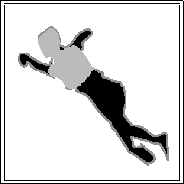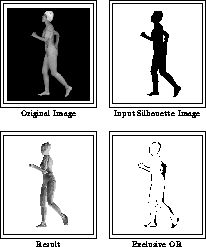Contents of this page are obsolete.
This page is preserved and stored at this URL just from historical viewpoint.
Original URL was http://www.mm.media.kyoto-u.ac.jp/members/kameda/...
Please visit
www.kameda-lab.org
for recent information. (2002/12/06, [email protected])
Kameda,
Research,
Documents and Info



Next: Conclusion
Up: Three Dimensional Pose Estimation
Previous: Experimental Results
Our proposed method shows its applicability through the experiment
for computer generated images. However, when we take up a real-life
object as the target a problem arises: the geometric features of
the model might not be precisely the same as those of the real-life
object. Since the method previously proposed refers only the contour
information and therefore is sensitive to the noise on the contour, it
is essential to extend the method to overcome this problem. The method
is modified on two points.
1. In Step 1, generated candidates must not
project Part i in a way that more than a certain amount of the
projected region strays from the silhouette. The amount should be
determined according to the geometric unlikeness of Part i to
the target real-life object.
2. In Step 2, the system first makes a ``gnawed
image.'' It is an image in which the silhouette contour is removed
from the given image and in which the regions projected by the parts
in  are also removed. Then, the system measures the exclusive
OR area between the silhouette on the gnawed image and the projected
region for each candidate. The candidate which makes the smallest
exclusive OR area is selected as the estimation of the rotation angles
of Part i.
are also removed. Then, the system measures the exclusive
OR area between the silhouette on the gnawed image and the projected
region for each candidate. The candidate which makes the smallest
exclusive OR area is selected as the estimation of the rotation angles
of Part i.
As an example, suppose the model is the same as that used in the
previous section and consider the situation when  contains the
head, neck, and breast part. The gnawed image at that time is shown in
Figure 5. The bright gray colored contour corresponds to
the removed contour and the dark gray colored region corresponds to
the removed projection region. Exclusive OR calculation is worked out
only in white or black colored regions. The dark gray colored region
has the role, like Step 2 in the previous proposed
method, of attracting the edge of the projected region to the
silhouette contour. In addition, since the bright gray colored contour
is out of consideration on counting the exclusive OR area, the system
acquires a tendency to rotate the parts in order to cover as much of
the black colored region as possible.
contains the
head, neck, and breast part. The gnawed image at that time is shown in
Figure 5. The bright gray colored contour corresponds to
the removed contour and the dark gray colored region corresponds to
the removed projection region. Exclusive OR calculation is worked out
only in white or black colored regions. The dark gray colored region
has the role, like Step 2 in the previous proposed
method, of attracting the edge of the projected region to the
silhouette contour. In addition, since the bright gray colored contour
is out of consideration on counting the exclusive OR area, the system
acquires a tendency to rotate the parts in order to cover as much of
the black colored region as possible.

Figure 5: Gnawed Image
We have implemented the modified method and tested several cases for
an image of a woman. In this experiment, the resolution of the pose
estimation is set to 20 degree and silhouette images are 320 pixels by
360 pixels. One of the results is shown in Figure 6. The
estimated pose is quite similar to the target woman's pose in the
original image. We show another case in Figure 7, where
the breast part is posed in a slightly wrong way. As a result, the
estimation of the right arm failed. The reason for this type of
failure is considered to be the method that does not examine uncovered
silhouette regions during the process. However, it would be very
expensive to compute a prediction for the part to be processed next,
so that it can reduce regions not covered in Step 1. This
problem is left for further study.

Figure 6: A Case of Real-Life Human

Figure 7: Another Case of Real-Life Human



Next: Conclusion
Up: Three Dimensional Pose Estimation
Previous: Experimental Results
Yoshinari Kameda
Thu Apr 3 22:11:48 JST 1997
 are also removed. Then, the system measures the exclusive
OR area between the silhouette on the gnawed image and the projected
region for each candidate. The candidate which makes the smallest
exclusive OR area is selected as the estimation of the rotation angles
of Part i.
are also removed. Then, the system measures the exclusive
OR area between the silhouette on the gnawed image and the projected
region for each candidate. The candidate which makes the smallest
exclusive OR area is selected as the estimation of the rotation angles
of Part i.



 contains the
head, neck, and breast part. The gnawed image at that time is shown in
Figure
contains the
head, neck, and breast part. The gnawed image at that time is shown in
Figure 

